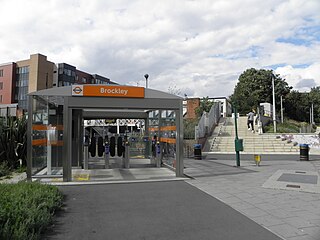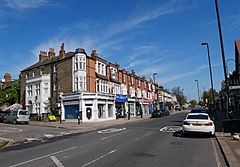
Bellingham is an area of South East London, England, within the London Borough of Lewisham. It lies south of Catford, east of Sydenham and north of Beckenham, and is part of the Catford postal district (SE6).

Brockley is a district and an electoral ward of south London, England, in the London Borough of Lewisham 5 miles (8 km) south-east of Charing Cross.

Catford is a district in south east London, England, and the administrative centre of the London Borough of Lewisham. It is southwest of Lewisham itself, mostly in the Rushey Green and Catford South wards. The population of Catford, including Bellingham, was 44,905 in 2011.

Lewisham is a London borough in south-east London; it forms part of Inner London. The principal settlement of the borough is Lewisham. The local authority is Lewisham London Borough Council, based in Catford. The Prime Meridian passes through Lewisham. Blackheath, Goldsmiths, University of London and Millwall F.C. are located within the borough.

Lewisham Deptford is a parliamentary constituency represented in the House of Commons of the UK Parliament since 2015 by Vicky Foxcroft of the Labour Party.

Lewisham is an area of southeast London, England, six miles south of Charing Cross. It is the principal area of the London Borough of Lewisham, and was within the historic county of Kent until 1889. It is identified in the London Plan as one of 35 major centres in Greater London, with a large shopping centre and street market. Lewisham had a population of 60,573 in 2011.

The River Ravensbourne is a tributary of the River Thames in south London, England. It flows into the tidal River Thames at Deptford, where its tidal reach is known as Deptford Creek.

Catford Bridge railway station is on the Mid-Kent Line, serving Hayes line trains from London to Hayes. It lies between Ladywell and Lower Sydenham stations, 7 miles 42 chains (12.1 km) from London Charing Cross and in Travelcard Zone 3. It is adjacent to Catford railway station on the Catford Loop line. The station entrance is on Catford Road, a part of the South Circular Road (A205), and has brick buildings on both platforms, though the up side building is no longer in use by the railway. The station is managed by Southeastern, who operate all trains serving it.

Grove Park is a district of South East London, England within the London Borough of Lewisham. It is located north east of Bromley and south east of Lewisham.

Crofton Park is a station on the 'Catford Loop' West Hampstead Thameslink to Sevenoaks route, between Nunhead and Catford. It is in Travelcard Zone 3.

Lewisham parks and open spaces are part of the "green lung" of London and include a diverse range of sites, from small urban parks and gardens to one of the most historic natural landscapes in Greater London at Blackheath. While overall control rests with London Borough of Lewisham, management of borough-owned parks and their facilities is contracted out to Glendale Grounds Management.

Ladywell is a locale in Lewisham in South East London, England, and a ward in the London Borough of Lewisham between Brockley, Crofton Park and Lewisham proper. It has ample green space including Ladywell Fields and Hilly Fields which borders Brockley. Ladywell Village, the main shopping area along Ladywell Road, was given a facelift in 2013 with £800,000 of Transport for London funding. The pavements were widened, short stay bays created to help local businesses and shoppers, and trees were added. Ladywell Village has a range of retail outlets including a number of cafes, a patisserie and a delicatessen.

Prendergast School is a girls' secondary school and sixth form located on Hilly Fields, Brockley, in the London Borough of Lewisham. It has an independent board of governors. The school motto is from Chaucer's Prologue to The Canterbury Tales: "Trouthe and Honour, Fredom and Curteisye".
Lewisham North was a parliamentary constituency in Lewisham, London which returned one Member of Parliament (MP) to the House of Commons of the Parliament of the United Kingdom from 1950 until it was abolished for the February 1974 general election.

The Greenwich Park branch line is a short section of railway line in south east London which links the Catford Loop line to the South Eastern Main Line which originally terminated at Greenwich Park station. It provides a link for freight trains travelling from north London to the south east, as well as a route for passenger trains from London Victoria station to destinations in South East London and Kent.

The Rivoli Ballroom is the only intact 1950s ballroom remaining in London, England. It is famed for its original decor and interior fittings, including red velvet, flock wallpaper, chandeliers, glitter balls and oversized Chinese lanterns. The venue is often used as a film location and plays host to many dance and musical events.

Blythe Hill Fields, also sometimes known as Blythe Hill is an area of elevated open land in the London Borough of Lewisham that commands panoramic views over Canary Wharf, the City, Kent and Surrey. The surrounding areas of Blythe Hill Fields involve Catford to the south and southeast, Crofton Park to the north, and Forest Hill to the west.

The Mid-Kent line is a British railway line running from Courthill Loop North junction to Hayes railway station in the London Borough of Bromley. Despite its name, none of the line is in the present-day county of Kent.

Ladywell Fields, originally Ladywell Recreation Ground is a public park in the London Borough of Lewisham created from three historic fields. It is located near Ladywell railway station at the northern end of the park, and Catford Bridge at the southern end.


























